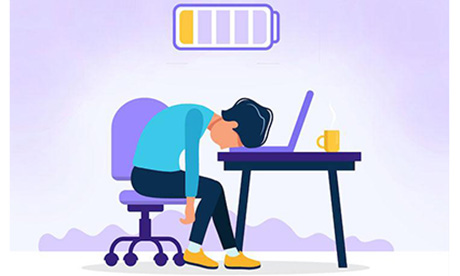Workplace burnout is soaring as workers find it harder to balance their work-life with pressures from the Covid-19 pandemic.
Among those suffering burnout are people working from home and people working in the not-for-profit sector, like church workers.
As worker burnout soars Covid looms behind the new high-stress figures.
The Wellbeing@Work study, led by Professor Jarrod Haar has been tracking 1000 people in the New Zealand workforce through four surveys, since February 2020.
Its results paint a sorry picture of burnout across all sectors.
Haar says workers who were tethered to their office via smart devices had the highest risk of burnout, followed by Māori employees and workers with high demands.
To have a high burnout risk, respondents needed to score high in all four dimensions:
- Exhaustion: both physically and mentally.
- Mental distance: employees no longer consider what they do has any value or worth.
- Emotional impairment: being unable to control your emotions, such as showing up to work and crying.
- Cognitive impairment: being distracted and forgetful at work.
Those who feel the most tied (or “tethered”) to their office (via smart devices) had a 652.3% higher risk of burnout.
Working from home has pushed people into staying connected to their office outside work hours, Kelly says.
He notes the latest cohort to report into his study has been through an extended lockdown affecting much of the country.
57% of respondents were working from home at least one day a week. Many juggle caregiving, teaching and working at the same time.
Managers and Maori have been particularly affected, Haar says.
“In the past two years, managers have been the glue holding workplaces and workforces together. People in these positions have likely been under tremendous pressure and serious damage is being done.
“Maori were over-represented in this study at 23.9% of the sample.
“They were well represented in management positions, but much were more likely to be male and have dependents, and they were slightly more likely to report higher work demands and face higher levels of bureaucracy in their workplace – a perfect storm of burn out.”
He suspects growing numbers of the workforce feel they are getting less enjoyment from their work. They also describe their minds “spinning” since the first Covid-19 lockdown.
Haar says the failure for anxiety to drop over the better part of a year shows New Zealand workers are deeply worried and anxious about their jobs.
“The biggest driver of this mental health concern is a persistent worry about job insecurity. This has remained relatively high and unchanged across the three time periods. Kiwis are worried about their job and future,” Haar says.
Haar thinks organisations could consider doing a bit more to acknowledge their employees’ dedication and fatigue.
But don’t beat yourself up, he adds.
“It has been a tough year for everyone. Focus on what matters – rest and restoration away from work.”
Haar’s results show:
- Those who feel the most tied (or “tethered”) to their office (via smart devices) had a 652.3% higher burnt-out risk
- Māori employees had a 593.9% higher burnt-out risk
- Workers with high work demands (e.g., too much work to do) had a 572.4% higher burnt-out risk
- Workers in highly bureaucratic firms had a 405.7% higher burnt-out risk
- Those with dependents had a 257.5% higher burnt-out risk
- Managers had a 235.5% higher burnt-out risk
- Males had a 222.6% higher burnt-out risk
- Those working-from-home had a 197.1% higher burnt-out risk
- Full-time workers had a 147.3% higher burnt-out risk
- No difference by sector (private v. public v. not-for-profit).
- No difference for younger employees (under 30yrs)
Source
- RNZ
- AUT
- Voxy
- Supplied
- Image: Waatea News
